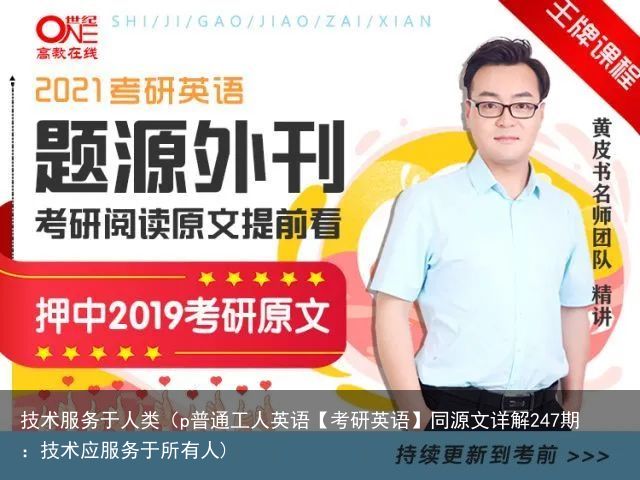技术服务于人类(p普通工人英语【考研英语】同源文详解247期:技术应服务于所有人)
点击蓝字
关注我们

原文期刊:Project Syndicate《报业辛迪加》
原文标题:
Technology for All 技术应服务于所有人
本文选自2020.03.06 Project Syndicate《报业辛迪加》Technology for All(技术应服务于所有人)。主题:本文针对“技能差距”提出一种常遭忽视的应对策略,即人为引导技术创新为社会服务。
脉络:
提出“技能差距”日益扩大的问题(第一段)——对比提出应对策略(第二、三段)——揭示人们忽视这种应对策略的原因并予以反驳(第四、五段)——明确提议(第六段)——重申作者观点(第七段)。
Part 1
原文
I We live in a world with an ever widening chasm between the skills of the “average” worker and the capabilities demanded by frontier technologies. Robots, software, and artificial intelligence have increased corporate profits and raised demand for skilled professionals. But they replace factory, sales, and clerical workers—hollowing out the traditional middle class. This “skills gap” contributes to deepening economic inequality and insecurity and ultimately to political polarization—the signal problems of our time.
II The conventional response is more and better education. If ordinary people are not to be left behind in this age old “race between education and technology,” societies need to do a much better job in training and retraining their workforce for new technologies. Truck drivers need to become computer programmers.
III This is an oddly one sided remedy. As a matter of logic, the gap between skills and technology can be closed in one of two ways: either by increasing education to match the demands of new technologies, or by redirecting innovation to match the skills of the current (and prospective) labor force. The second strategy barely gets lip service in policy discussions. Yet it is the more obvious, and possibly more effective strategy.
IV The blind spot is the product of a certain kind of technology worship that views innovation as an exogenous force behaving according to its own rules. We tend to think we have little control over innovation. It is society that must adjust to technological change, instead of vice versa.
V This perspective overlooks the degree to which innovation is driven by values—often unstated—and incentives.Governments play a ubiquitous role in shaping the technological landscape. Advanced economies commonly rely on subsidies for research and development, funding of basic scientific research, patent rules, loan guarantees, cluster development policies, and direct government support for frontier technologies. All of these policies tilt the playing field to determine what kind of innovations take place.
VI Instead of replacing semi skilled or unskilled labor with machines, societies can push innovations that specifically increase the tasks that ordinary workers are able to perform. This could be achieved through new technologies that either allow workers to do the work that was previously performed by more skilled people, or enable the provision of more specialized, customized services by the existing workforce.
VII A fundamental reason why society under invests in innovations that benefit ordinary people has to do with the distribution of power. Science and technology are designed to provide answers and solve problems. But which questions are asked and whose problems are solved depends on whose voice gets the upper hand. Technological change does not follow its own direction. It is shaped by moral frames, incentives, and power. If we think more about how innovation can be directed to serve society, we can afford to worry less about how we should adjust to it.
Part 2
词汇短语
1. corporate [ˈkɔːpərət] a. 公司的,企业的
2. hollow out 挖空,空心化
3. polarization [ˌpəʊləraɪˈzeɪʃn] n. 两极分化
4. signal [ˈsɪɡnəl] a. 显著的,作为信号的
5. programmer [ˈprəʊɡræmə(r)] n. (计算机) 程序员
6. oddly [ˈɒdli] ad. 奇怪地
7. onesided [ˌwʌn ˈsaɪdɪd] a. 片面的,单方面的
8. remedy [ˈremədi] n. 解决办法
9. redirect [ˌriːdəˈrekt , ˈriːdərekt] v. 使转向,使改变方向
10. prospective [prəˈspektɪv] a. 未来的
11. lip service口头上的支持
12. blind spot看不到某物的重要性
13. tilt [tɪlt] v. 使倾斜
14. specialized [ˈspeʃəlaɪzd] a. 专业化的; 专门的
15. customized [ˈkʌstəmaɪzd] a. 定制的
16. get the upper hand占上风
17. *chasm [ˈkæzəm] n. 鸿沟,分歧
18. *clerical [ˈklerɪkl] a. 办公室文书工作的
19. *exogenous [ekˈsɒdʒənəs] a. 外生的,外源的
20.*ubiquitous [juːˈbɪkwɪtəs] a. 无所不在的
(标*为超纲词汇)
Part 3
翻译点评
I We live in a world with an ever widening chasm between the skills of the “average” worker and the capabilities demanded by frontier technologies. Robots, software, and artificial intelligence have increased corporate profits and raised demand for skilled professionals. But they replace factory, sales, and clerical workers—hollowing out the traditional middle class. This “skills gap” contributes to deepening economic inequality and insecurity and ultimately to political polarization—the signal problems of our time.
[翻译] 我们生活在这样一个世界里:“普通”工人的技能水平与前沿技术所要求的能力之间的鸿沟不断扩大。机器人、软件和人工智能提高了公司的利润,扩大了对专业技术人员的需求,但也取代了工厂工人、销售和文职人员——挖空了传统意义上的中产阶级。这一“技能差距”不断加剧经济不平等与经济不安全,并最终导致政治上的两极分化——这些都是我们这个时代的标志性问题。
[点评] 提出问题:“技能差距”日益扩大。chasm/(skills) gap同义复现提出文章中心话题“技能差距”,动词increased/raised/replace/hollowing out/contributes to表明本段聚焦其影响。
主要逻辑衔接:开篇We live in a world引出关注问题“劳动者的实际技能水平与前沿技术所要求的劳工技能水平之间的差距日益扩大”;随后两句介绍技术发展的双面影响;末句总结技能差距的严重后果——深化经济不平等、不安全,最终导致政治分化。
核心关键词:an ever widening chasm。
II The conventional response is more and better education. If ordinary people are not to be left behind in this age old “race between education and technology,” societies need to do a much better job in training and retraining their workforce for new technologies. Truck drivers need to become computer programmers.
[翻译]常规的应对办法是让人们接受更多更好的教育。在这场旷日持久的“教育与技术竞赛”中,要让普通人不掉队,社会需在劳动力新技术培训与再培训方面取得更好的成果。需将卡车司机变成计算机程序员。
[点评]介绍常规应对办法:加大教育力度,提高教育质量。本段以response回应首段“技能差距带来诸多问题”,need to复现聚焦技能差距的应对办法。
主要逻辑衔接:首句先概述常规应对办法,第二句具体提议“社会应在新技术的培训和再培训方面做得更好”,末句以“培训卡车司机以使其转型为程序员”为例说明。
核心关键词:conventional response。
III This is an oddly one sided remedy. As a matter of logic, the gap between skills and technology can be closed in one of two ways: either by increasing education to match the demands of new technologies, or by redirecting innovation to match the skills of the current (and prospective) labor force. The second strategy barely gets lip service in policy discussions. Yet it is the more obvious, and possibly more effective strategy.
[翻译]这是一种奇怪的“一边倒”的方法。逻辑上,技能与技术之间的差距可通过两种方式消除:提供更多教育以匹配新技术的需求,或是重新引导创新以匹配当前(和未来)劳动力的技能水平。第二种策略在政策讨论中鲜见提及,却更显而易见,可能也更有效。
[点评] 对比提出更有效的应对策略:通过创新使技术契合当下和未来劳动力的技能。one sided/one of two ways/either...or.../The second/the more obvious...more effective等明示或暗示对比,表明本段主要比较两种应对策略。
主要逻辑衔接:首句承上评价常规应对策略只从一个角度考虑问题,提示下文将从另一角度提出应对策略;第二句介绍理论上的两种应对策略;末两句指出第二种策略虽鲜见于政策讨论,但实际上更显而易见,更有效。
核心关键词:the more obvious, and possibly more effective strategy
IV The blind spot is the product of a certain kind of technology worship that views innovation as an exogenous force behaving according to its own rules. We tend to think we have little control over innovation. It is society that must adjust to technological change, instead of vice versa.
[翻译] 这种忽视是某种技术崇拜的产物,这种技术崇拜将创新视为按其自身规律行事的外在力量。我们倾向于认为人类几乎无法控制创新。社会必须适应技术变化,而非反之。
[点评]揭示人们忽视第二种应对策略的原因:过分崇拜技术。The blind spot回指上段末“政策制定者对第二种应对策略的忽视”,因果表达the product of...明确本段聚焦原因分析。
主要逻辑衔接:首句概述原因“技术崇拜”;末两句具体阐释:人们正是由于普遍抱着这种心理,才认为社会必须适应技术创新,而非技术应服务社会。
核心关键词:technology worship
V This perspective overlooks the degree to which innovation is driven by values—often unstated—and incentives.Governments play a ubiquitous role in shaping the technological landscape. Advanced economies commonly rely on subsidies for research and development, funding of basic scientific research, patent rules, loan guarantees, cluster development policies, and direct government support for frontier technologies. All of these policies tilt the playing field to determine what kind of innovations take place.
[翻译]这种观点忽视了价值观(通常并不阐明)和激励措施在很大程度上对创新的驱动作用。在技术格局的塑造过程中随处可见政府的身影。发达经济体通常可依靠研发补贴、基础科研拨款、专利法规、贷款担保、集群发展政策以及政府对前沿技术的直接支持。所有这些政策都左右着创新领域,决定哪种创新得以进行。
[点评]驳斥“技术崇拜”,指出政府及其政策对创新发挥着重要的推动作用。This perspective回指上段technology worship,overlooks明确作者的否定立场。
主要逻辑衔接:首句概述“技术崇拜”观的问题:忽视了创新背后的价值观和激励措施;末三句以政府为例说明。
核心关键词:①Governments;②policies。
VI Instead of replacing semi skilled or unskilled labor with machines, societies can push innovations that specifically increase the tasks that ordinary workers are able to perform. This could be achieved through new technologies that either allow workers to do the work that was previously performed by more skilled people, or enable the provision of more specialized, customized services by the existing workforce.
[翻译]社会不应以机器取代半熟练和无技能劳工,而应推动创新,专门增加普通劳工有能力完成的工作。这可以通过新技术实现,这些新技术可使劳动者得以从事以往由更高技能人员完成的工作,或使现有劳动力能够提供更专业化、定制化的服务。
[点评]顺承第二种应对策略明确提出建议。can/could be achieved through...表明本段为建议段。
主要逻辑衔接:首句一取一舍(Instead of)提出总体建议;末句具体介绍两种解决思路(either...or...):技术创新可通过降低技能门槛,或帮助提供专业定制化服务来增加普通劳动者可以胜任的工作。
核心关键词:push innovations that...increase the tasks。
VII A fundamental reason why society under invests in innovations that benefit ordinary people has to do with the distribution of power. Science and technology are designed to provide answers and solve problems. But which questions are asked and whose problems are solved depends on whose voice gets the upper hand. Technological change does not follow its own direction. It is shaped by moral frames, incentives, and power. If we think more about how innovation can be directed to serve society, we can afford to worry less about how we should adjust to it.
[翻译]社会对造福普通百姓的创新投资不足的根本原因与权力分配有关。科学和技术旨在提供答案、解决问题。但是哪些问题得以提出、谁的难题得以解决则取决于谁的声音占上风。技术变化并非遵循自身方向,而是被道德框架、激励措施和权力所塑造。我们如果更多思考如何引导创新为社会服务,就不用太担心应如何适应创新。
[点评]揭示社会未能引导正确创新取向的原因并重申作者观点:我们应思考如何使技术创新服务于社会。A fundamental reason开启原因分析,If we...we can...总结全文。
主要逻辑衔接:前三句先分析创新未能惠及普通劳工的原因:权力分配不均;后三句再次指出技术变化受外在力量影响,强调我们有对其进行引导的可能和必要。
核心关键词:①distribution of power;②innovation...directed to serve society


右下角的每一枚“在看”
都是小编找更多资料的动力

我知道你“在看”哟~

